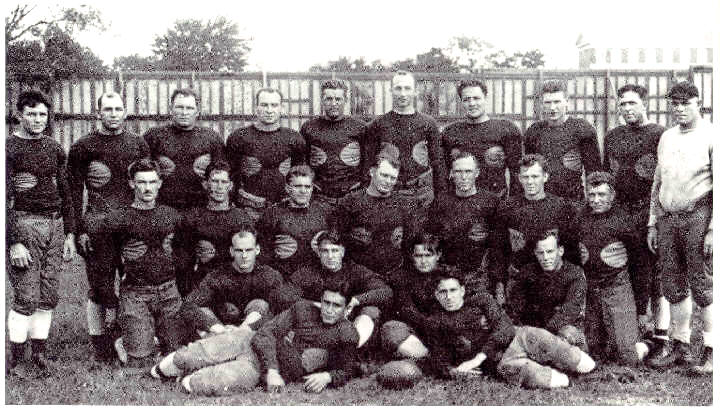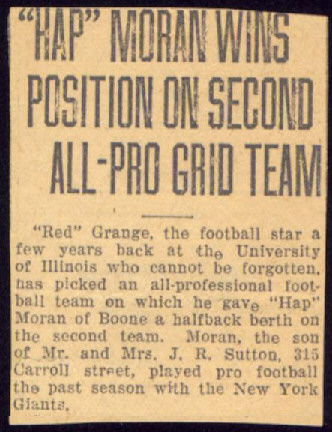| Hap Moran 1901 - 1994 continued: In 1926 there was no championship game.
Standings were based on win/loss percentages. The critical game for the NFL top spot
in 1926 was the Yellow Jackets against the Bears on December 4. The Bears were
especially tough because they had Paddy Driscoll on the squad. He had been sold by
the Cardinals to the Bears to avoid his acquisition by Red Grange’s American Football
League. Dad was sidelined by injuries received in a 7 to 6 victory over the Detroit
Panthers the week before. The Yellow Jackets were down 6 - 0 with 90 seconds left,
but then fullback Hust Stockton threw a pass to Ralph “Two-Bits” Homan for a
touchdown. Tex Hamer’s extra point gave Frankford the victory. (Stockton's
grandson, John, later went on to great fame playing for the Utah Jazz from 1984 to 2003 in
the NBA.) |
||

For winning the league championship my father was given a gold
watch. This came from the Frankford Athletic Association, not from the NFL.
There was no cash bonus. Frankford was set up as a charitable organization, so all
proceeds above costs were given away in the community. In 1926 they were able to
donate a coal heater to the Frankford Day Nursery.
|
||
| When my Dad returned to Iowa after the season, he
received a handwritten letter from the Frankford management. At the end of the year
banquet they had forgotten to ask him to return for the 1927 season, and they were
terribly sorry about this oversight. With player-coach Guy Chamberlin leaving to
join the Chicago Cardinals, they were especially worried about Dad’s return. In
the end, he did return, but only for the first part of the 1927 season. Then he
followed Chamberlin to Chicago. Reading the clippings, its seems that Dad was almost the whole Frankford offense at the start of the season. Even though Chamberlin was gone, the “Yellow Jacket Buzz” did it’s best to encourage the fans: |
||
|
||
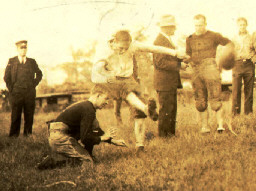
He was getting many more opportunities to dropkick and placekick the ball. In the second game of the season he made the first score on a pass reception followed by a 40 yard touchdown run, then kicked the extra point. In the second half he kicked a 46-yard field goal. Two weeks later he was again a the mainstay of the offense.
|
||
|
||
| The Chicago Cardinals | ||
| Guy Chamberlin and the Chicago Cardinals continued to beckon - they wanted Dad for his kicking skills. By the end of October Dad had left the East Coast and was playing in the Windy City. In his first game as a Cardinal he scored their only touchdown as they lost to Red Grange and the New York Yankees 7 to 6. | ||
|
||
| Dad ended the 1927 season with 27 points, 12th in the
league overall and 2nd in Field Goals. |
||
| The Posttsville Maroons | ||
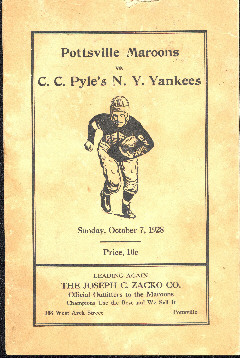 In 1928 Dad moved to Pottsville. The 1928 roster would produce three Hall of Fame players - Pete Henry, Walt Kiesling, and Johnny Blood. Dad started as halfback and although the team didn’t do that well, two important developments took place. The Maroons helped him develop his skills as a pass receiver and, in the game against the Giants, Steve Owen knocked himself unconscious trying to tackle my Dad. That began a life-long friendship and a move to New York to end the season with the Giants. He stayed with Mr. Mara’s team for six years.
|
||
| The New York Giants | ||
| The next three years were great ones for Dad. In
1929 he was teamed up with Benny Friedman, Tony Plansky, Len Sedbrook, and Ray Flaherty.
They provided the Giants with a tremendous scoring punch. The Giants scored 312
points in the 1929 season and ended up second in the NFL with a record of 13-1-1.
Dad caught four of Friedman’s 20 touchdown passes, ending the season with 30
points. He had an especially great game against his former Frankford teammates when
he ran back an interception for 50 yards and a TD, caught a Friedman pass in the end zone,
and passed for a touchdown to Mickey Murtagh.
|
||
|
||
| Another big victory in the season was a 34 - 0 win over the Bears. Again, the combination of Friedman to Moran was critical to the victory: | ||
|
||
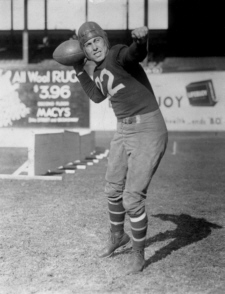 The week after their 34 - 0 romp over the Bears, the Giants
lost to Green Bay 6 to 0. The Green Bay touchdown was set up by an interception of a
Friedman pass deep in Giants territory. This loss cost the Giants the NFL title that
year, as Green Bay finished 12 -0-1. The week after their 34 - 0 romp over the Bears, the Giants
lost to Green Bay 6 to 0. The Green Bay touchdown was set up by an interception of a
Friedman pass deep in Giants territory. This loss cost the Giants the NFL title that
year, as Green Bay finished 12 -0-1.That order of finish would be repeated in the 1930 season: Green Bay in first place, the Giants in second. Two games stand out in my Grandmother’s scrapbook. She traveled from Iowa to Chicago to see her son play against the Chicago Cardinals, and he must have been inspired by her presence as he passed for one touchdown, rushed for one touchdown, and kicked an extra point in a 13 to 6 win over the Cards. |
||
|
||
| Officially Dad scored 27 points in 1930, but his best play of the year resulted not in a touchdown but in a record setting 91-yard run that ended on the one yard line. (That set the NFL record for the longest run from scrimmage, a record that stood for nine years - it remained the Giants record for 75 years, broken by Tiki Barber against Oakland on December 31, 2005.) The opponent in 1930 was the Green Bay Packers, the place was the Polo Grounds, and the crowd was large because it was Chris Cagle’s first game as a pro after his All American play for Army. But Cagle didn’t last long in that game. Ten minutes into the game, with a deep gash in his forehead, Cagle was taken out and Dad went in to finish the game. | ||
|
||
|
The 1930 season ended on a high note - the famous exhibition game
between the Giants and the Notre Dame All Stars, featuring the Four Horsemen (see article). Dad threw the final
touchdown pass of the game, which turned out to be the last points ever scored against a
team coached by Knute Rockne. After the game Rockne told his All Stars, “That
was the greatest football machine I ever saw. I’m glad none of you got
hurt.” |
||
| Dad’s game was very balanced in 1931 and he was
given opportunities to score in every category. He was 4th in the league in field
goals and 3rd in points after touchdown. He scored rushing, passing, and receiving.
He also did some of New York’s punting. In a game against Green Bay he threw a
54-yard pass to Ray Flaherty and then kicked a 27 yard field goal. Although the
Giants ended the season with a 25 to 6 victory over the Bears, their record was only
7-6-1, a disappointment after coming so close to the Championship the year before. The Giants had two big problems in 1932. Benny Friedman went over to Brooklyn as a player-coach and the team, like my Dad, was growing older. Tim Mara had a solution for one older player; he asked veteran Steve Owen to take over as head coach. Despite a difficult beginning, Owen remained in that position for 23 years. The Giants dropped the first three games of the season, all on the road. Their opening home game, against Brooklyn, seemed to turn the tide. The 20-12 victory included a 71- yard touchdown run by Dad. The turn-around was short lived. A tie and two losses made for a disastrous 1-5-1 start to Steve Owen’s coaching career. Owen turned to Jack McBride, scoring leader for the Giants in ‘25, ‘26, and ’27. He led the Giants to victories first over Stapleton and then over undefeated League Champion Green Bay. The 6-0 win over the Packers was the major upset of the season, and Dad caught a 16-yard pass as part of the touchdown drive.  McBride helped the Giants win games, but added to
the aging problem. At the end of the 4-6-2 season, 16-year-old Wellington Mara
handed his father a list of college players the Giants should go after to rejuvenate the
team. This was ridiculed in the New York press with lines like, “Papa, please
buy me a tackle.” But on that list was the key to the success of the 1933
season -- Harry Newman, the All-America from Michigan. McBride helped the Giants win games, but added to
the aging problem. At the end of the 4-6-2 season, 16-year-old Wellington Mara
handed his father a list of college players the Giants should go after to rejuvenate the
team. This was ridiculed in the New York press with lines like, “Papa, please
buy me a tackle.” But on that list was the key to the success of the 1933
season -- Harry Newman, the All-America from Michigan.The Giants also acquired the services of Ken Strong in 1933. Strong had played for Stapleton since 1929, but his real interest was baseball. A botched wrist surgery dashed his baseball hopes, and Stapleton folded after the 1932 season, so the Giants signed him at a bargain $250 per game. It may well have been the best deal in their history. Dad had tough competition for playing time in 1933. In addition to Ken Strong there was rookie Kink Richards, Bo Molenda, Stu Clancy, and Dale Burnett in the backfield. Ends were Red Badgro, Glenn Campbell, and Ray Flaherty. Dad was alternating in the backfield with Strong in the beginning of the season, and played a major role in the Giants 56-0 win over the Eagles. In that game he set an NFL record for the most yards receiving in a single game - 114 yards on three catches. The record stood until 1937 when it was broken by Gaynell Tinsley of the Chicago Cardinals. |
||
|
||
It was a critical win for the Giants. They turned
the corner from a .500 season to the divisional title. For my Dad his touchdown and
extra point was his last score, and last headline, as a New York Giant. Ken Strong
came to dominate and Dad’s injuries and age caught up with him. The Giants went
on to play in the first NFL Championship game that year, a 23-21 loss to the Chicago
Bears. Sitting on the bench Dad saw Red Grange tackle Red Badgro and break up the
Giants last hope for a win in a game where the lead changed hands six times. |
||
| When Dad died in 1994, I received a letter from a woman who had been a cheerleader for the Mustangs. Now in her 70’s, she noted how many of those Mustang players went into the service during the war, and how the lessons they learned on the football field served them well. Not everyone came home, but those who did had an annual reunion in Florida, and still remembered having the former Giant as their mentor. She wrote: “He was an idol to the players. They were awed that they had the great Hap Moran as their coach.” I’m sure that, as much as any headline or record, would have brought a smile again to Hap’s face. | ||
Return to Home Page |
